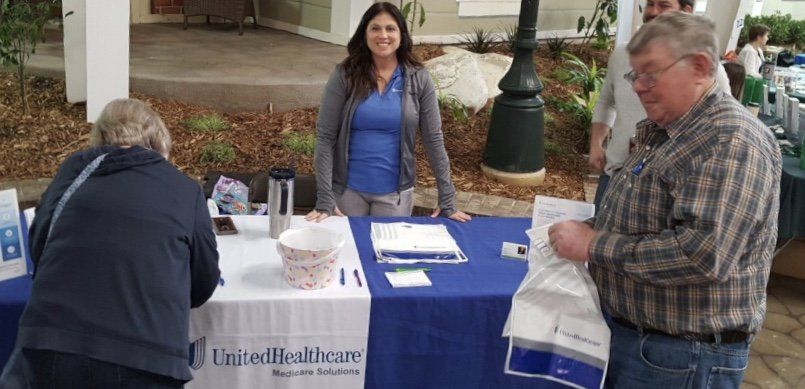Medicare Options For You
Lindsay is a Medicare and Social Security Specialist. She is passionate about protecting those who are nearing or already in retirement. Lindsay presents her clients with the Medicare options available and explains each one to help them choose the best option for their situation.

*Lindsay visiting with seniors at the Victorian Gardens Senior Expo.
Basics of Medicare
Medicare is the federal health insurance plan for people who are 65 and older, as well as people with endistage renal disease, along with certain younger people with disabilities. Lindsay Lampe can help you navigate the process, and enroll in the correct Medicare plan.
Medicare Part A
Medicare Part A is just hospital insurance. It helps pay for hospital care, as well as inpatient care at a skilled nursing facility after a hospital stay.
Medicare Part B
Medicare Part B pays offers more general health coverage. In addition to hospital stays covered by Part A, Medicare Part B covers doctor visits, lab services, x-rays, preventive services and medical supplies.

Other Medicare Plans
Prescription Drug Plans
Medicare Prescription Drug Plans, or Part D, helps cover the costs associated with prescriptions, as well as recommended shots or vaccines. We well help you enroll in this drug plan, and make sure that the medicine you need is covered by the plan.
Medicare Advantage
Medicare Advantage, or Part C is offered by private insurance If you choose an HMO plan, it has managed care, and includes copay within your network. If you choose PPO, it has a monthly premium, along with copays out of the network. Both plans typically include prescription drug coverage, along with coverage for vision care, hearing care, dental care, and gym membership. e companies that are approved by Medicare. This allows you additional options to customize your medical care and treatment based on your specific needs and wishes. You have the option to choose either an HMO plan or a PPO plan.
Medicare Supplements
Medicare Supplements, also known as Medigap insurance, allows additional assistance to bridge the gap of out of pocket health care expenses. This provides additional coverage and administrated through a private insurance company. This helps pay for things like deductibles, copays, and other qualifying health care expenses that can add up over time.

Enrollment Periods
Initial Enrollment Period (IEP)
Allows you to sighn up three months after you turn 65.
Annual Enrollment Period (AEP)
October 15 – December 7
Open Enrollment Period (OEP)
January 1 to March 31
Special Enrollment Periods (SEP)
Individuals who drop their employer group health plan, qualify for the Extra Help (Low-Income Subsidy (LIS)) program, or eligible for both Medicare and Medicaid benefits (Dual-eligibility).
I am eligible for Medicare, how do I enroll?
Apply for Medicare Online (A and B) -https://www.ssa.gov/benefits/medicare/ look for the bright blue box in the middle of the page that says Apply for Medicare Only and follow the prompts.
How much is Part B?
Some people automatically get Medicare Part B (Medical Insurance), and some people need to sign up for Part B. Learn how and when you can sign up for Part B.
If you don't sign up for Part B when you're first eligible, you may have to pay a late enrollment penalty.
How much does Part B cost?
Part B premiums
You pay a premium each month for Part B. Your Part B premium will be automatically deducted from your benefit payment if you get benefits from one of these:
- Social Security
- Railroad Retirement Board
- Office of Personnel Management
If you don’t get these benefit payments, you’ll get a bill.
Most people will pay the standard premium amount. If your modified adjusted gross income is above a certain amount, you may pay an Income Related Monthly Adjustment Amount (IRMAA). Medicare uses the modified adjusted gross income reported on your IRS tax return from 2 years ago. This is the most recent tax return information provided to Social Security by the IRS.
2024
The standard Part B premium amount in 2024 is $174.70. Most people pay the standard Part B premium amount. If your modified adjusted gross income as reported on your IRS tax return from 2 years ago is above a certain amount, you'll pay the standard premium amount and an Income Related Monthly Adjustment Amount (IRMAA). IRMAA is an extra charge added to your premium.
If your yearly income in 2022 (for what you pay in 2024) was
| File individual tax return | File joint tax return | File married & separate tax return | You pay each month (in 2024) |
|---|---|---|---|
| Less than or equal to $103,000 | Less than or equal to $206,000 | $0.00 | $174.70 |
| Greater than $103,000 and less than or equal to $129,000 | Greater than $206,000 and less than or equal to $258,000 | $69.90 | $244.60 |
| Greater than $129,000 and less than or equal to $161,000 | Greater than $258,000 and less than or equal to $322,000 | $174.70 | $349.40 |
| Greater than $161,000 and less than or equal to $193,000 | Greater than $322,000 and less than or equal to $386,000 | $279.50 | $454.20 |
| Greater than $193,000 and less than $500,000 | Greater than $386,000 and less than $750,000 | $384.30 | $559.00 |
| Greater than or equal to $500,000 | Greater than or equal to $750,000 | $419.30 | $594.00 |
Part B deductible & coinsurance
In 2024, you pay $240 for your Part B deductible. After you meet your deductible for the year, you typically pay 20% of the Medicare-approved amount for these:
- Most doctor services (including most doctor services while you're a hospital inpatient)
- Outpatient therapy
- Durable Medical Equipment (DME)
What is the Late Enrollment Penalty?
If you didn't get Part B when you're first eligible, your monthly premium may go up 10% for each 12-month period you could've had Part B, but didn't sign up. In most cases, you'll have to pay this penalty each time you pay your premiums, for as long as you have Part B. And, the penalty increases the longer you go without Part B coverage.
Usually, you don't pay a late enrollment penalty if you meet certain conditions that allow you to sign up for Part B during a Special Enrollment Period. Read more about different situations that may affect when you decide to get Part B.
If you have limited income and resources, your state may help you pay for Part A, and/or Part B. You may also qualify for Extra Help to pay for your Medicare prescription drug coverage.
Example:
Your Initial Enrollment Period ended December 2016. You waited to sign up for Part B until March 2019 during the General Enrollment Period. Your coverage starts July 1, 2019. Your Part B premium penalty is 20% of the standard premium, and you’ll have to pay this penalty for as long as you have Part B. (Even though you weren't covered a total of 27 months, this included only 2 full 12-month periods.)
What is IMRAA (Income-Related Monthly Adjustment Amount)?
Most drug plans charge a monthly fee that varies by plan. You pay this in addition to the Part B premium. If you're in a Medicare Advantage Plan (Part C) or Medicare Cost Plan with drug coverage, the monthly premium may include an amount for drug coverage.
Note
The same insurance company may offer Medigap policies and Medicare drug plans.
If you join a Medigap policy and a Medicare drug plan offered by the same company, you may need to make 2 separate premium payments for your coverage. Contact your insurance company for more details.
Get your premium automatically deducted
Contact your plan (not Social Security or the Railroad Retirement Board (RRB)) if you want your premium deducted from your monthly Social Security or RRB payment. If you want to stop premium deductions and get billed directly, contact your plan.
How much does Part D cost?
Most people only pay their Part D premium. If you don't sign up for Part D when you're first eligible, you may have to pay a Part D late enrollment penalty.
If you have a higher income, you might pay more for your Medicare drug coverage. If your income is above a certain limit ($87,000 if you file individually or $174,000 if you’re married and file jointly), you’ll pay an extra amount in addition to your plan premium (sometimes called “Part D-IRMAA”). You’ll also have to pay this extra amount if you’re in a Medicare Advantage Plan that includes drug coverage. This doesn’t affect everyone, so most people won’t have to pay an extra amount. If you have Part B and you have a higher income, you may also have to pay an extra amount for your Part B premium, even if you don’t have drug coverage. The chart below lists the extra amount costs by income.
Social Security will contact you if you have to pay Part D IRMAA, based on your income. The amount you pay can change each year. If you have to pay a higher amount for your Part D premium and you disagree (for example, if your income goes down), use this form to contact Social Security [PDF, 125 KB]. If you have questions about your Medicare drug coverage, contact your plan.
Note
The extra amount you have to pay isn’t part of your plan premium. You don’t pay the extra amount to your plan. Most people have the extra amount taken from their Social Security check. If the amount isn’t taken from your check, you’ll get a bill from Medicare or the Railroad Retirement Board. You must pay this amount to keep your Part D coverage. You’ll also have to pay this extra amount if you’re in a Medicare Advantage Plan that includes drug coverage.
If Social Security notifies you about paying a higher amount for your Part D coverage, you’re required by law to pay the Part D-Income Related Monthly Adjustment Amount (Part D IRMAA). If you don’t pay the Part D IRMAA, you’ll lose your Part D coverage.
Employer/Union coverage and Part D IRMAA
Note You pay your Part D IRMAA directly to Medicare, not to your plan or employer.
You’re required to pay the Part D IRMAA, even if your employer or a third party (like a teacher’s union or a retirement system) pays for your Part D plan premiums. If you don’t pay the Part D IRMAA and get disenrolled, you may also lose your retirement coverage and you may not be able to get it back.
Things to remember
- Pay your Part D IRMAA bill to Medicare as soon as you get it. Find out how to pay your bill. Keep your address current with Social Security, even if you don’t get a Social Security check.
Part D premiums by income
The chart below shows your estimated prescription drug plan monthly premium based on your income as reported on your IRS tax return. If your income is above a certain limit, you'll pay an income-related monthly adjustment amount in addition to your plan premium.
2024 - If your filing status and yearly income in 2022 was:
| File individual tax return | File joint tax return | File married & separate tax return | You pay each month (in 2024) |
|---|---|---|---|
| Less than or equal to $103,000 | Less than or equal to $206,000 | $0.00 | $174.70 |
| Greater than $103,000 and less than or equal to $129,000 | Greater than $206,000 and less than or equal to $258,000 | $69.90 | $244.60 |
| Greater than $129,000 and less than or equal to $161,000 | Greater than $258,000 and less than or equal to $322,000 | $174.70 | $349.40 |
| Greater than $161,000 and less than or equal to $193,000 | Greater than $322,000 and less than or equal to $386,000 | $279.50 | $454.20 |
| Greater than $193,000 and less than $500,000 | Greater than $386,000 and less than $750,000 | $384.30 | $559.00 |
| Greater than or equal to $500,000 | Greater than or equal to $750,000 | $419.30 | $594.00 |
What is the Donut Hole?
Most Medicare drug plans have a coverage gap (also called the "donut hole"). This means there's a temporary limit on what the drug plan will cover for drugs.
Not everyone will enter the coverage gap. The coverage gap begins after you and your drug plan have spent a certain amount for covered drugs. Once you and your plan have spent $5, 030 on covered drugs in 2024, you're in the coverage gap. This amount may change each year. Also, people with Medicare who get Extra Help paying Part D costs won’t enter the coverage gap.
Brand-name prescription drugs
Once you reach the coverage gap, you'll pay no more than 25% of the cost for your plan's covered brand-name prescription drugs. You'll pay this discounted rate if you buy your prescriptions at a pharmacy or order them through the mail. Some plans may offer you even lower costs in the coverage gap. The discount will come off of the price that your plan has set with the pharmacy for that specific drug.
Although you'll pay no more than 25% of the price for the brand-name drug, almost the full price of the drug will count as out-of-pocket costs to help you get out of the coverage gap. What you pay and what the manufacturer pays (95% of the cost of the drug) will count toward your out-out-pocket spending. Here's a breakdown:
- Of the total cost of the drug, the manufacturer pays 70% to discount the price for you. Then your plan pays 5% of the cost. Together, the manufacturer and plan cover 75% of the cost. You pay 25% of the cost of the drug.
- There’s also a dispensing fee. Your plan pays 75% of the fee, and you pay 25% of the fee.
What the drug plan pays toward the drug cost (5% of the cost) and dispensing fee (75% of the fee) aren't counted toward your out-of-pocket spending.
Example
Mrs. Anderson reaches the coverage gap in her Medicare drug plan. She goes to her pharmacy to fill a prescription for a covered brand-name drug. The price for the drug is $60, and there's a $2 dispensing fee that gets added to the cost, making the total price $62. Mrs. Anderson pays 25% of the total cost ($62 x .25 = $15.50).
The amount Mrs. Anderson pays ($15.50) plus the manufacturer discount payment of $42 ($60 x .70 = $42) count as out-of-pocket spending. So, $57.50 counts as out-of-pocket spending and helps Mrs. Anderson get out of the coverage gap. The remaining $4.50, which is 5% of the drug cost ($3) and 75% of the dispensing fee ($1.50) paid by the drug plan, doesn't count toward Mrs. Anderson's out-of-pocket spending.
If you have a Medicare drug plan that already includes coverage in the gap, you may get a discount after your plan's coverage has been applied to the drug's price. The discount for brand-name drugs will apply to the remaining amount that you owe.
Generic drugs
Medicare will pay 75% of the price for generic drugs during the coverage gap. You'll pay the remaining 25% of the price. The coverage for generic drugs works differently from the discount for brand-name drugs. For generic drugs, only the amount you pay will count toward getting you out of the coverage gap.
Example
Mr. Evans reaches the coverage gap in his Medicare drug plan. He goes to his pharmacy to fill a prescription for a covered generic drug. The price for the drug is $20, and there's a $2 dispensing fee that gets added to the cost. Mr. Evans will pay 25% of the plan’s cost for the drug and dispensing fee ($22 x .25 = $5.50). The $5.50 he pays will be counted as out-of-pocket spending to help him get out of the coverage gap.
If you have a Medicare drug plan that already includes coverage in the gap, you may get a discount after your plan's coverage has been applied to the drug's price.
Items that count towards the coverage gap
- Your yearly deductible , coinsurance, and copayments
- The discount you get on brand-name drugs in the coverage gap
- What you pay in the coverage gap
Items that don't count towards the coverage gap
- The drug plan premium
- Pharmacy dispensing fee
- What you pay for drugs that aren’t covered
If you think you should get a discount
If you think you've reached the coverage gap and you don't get a discount when you pay for your brand-name prescription, review your next "Explanation of Benefits" (EOB). If the discount doesn't appear on the EOB, contact your drug plan to make sure that your prescription records are correct and up-to-date.
If your drug plan doesn't agree that you're owed a discount, you can file an appeal.